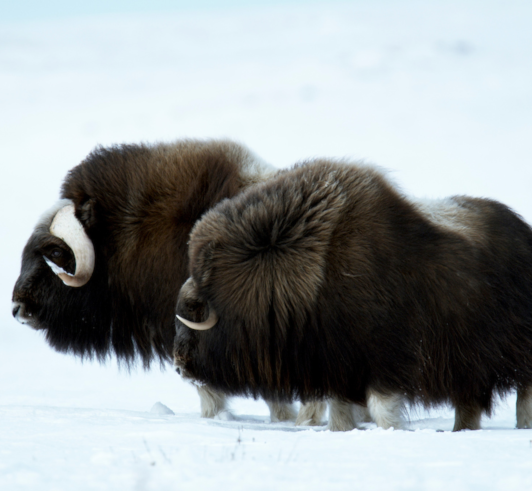WILDLIFE AND INDIGENOUS SUBSISTENCE
The wildlife of America’s Arctic is indelible to the Indigenous communities in the region. Native Peoples have made their home across Alaska’s North Slope for more than 20,000 years, and their survival - both then and now - is intrinsically tied to the wildlife that thrives alongside them.
The Caribou People
Along the Coastal Plain of the Arctic National Wildlife Refuge (ANWR), the Porcupine Caribou Herd completes a journey of more than 1,500 miles to give birth to the next generation of calves. It’s an epic pilgrimage they’ve been making for the last 2 million years.
Caribou are so central to the survival of the Gwich’in Peoples native to this region that they call the caribou birthing grounds Iizhik Gwats’an Gwandaii Goodlit - “The Sacred Place Where Life Begins.”
The Porcupine Caribou Herd is just one of four herds that migrate to the arctic North Slope of Alaska. Beyond the tenuous protection of the Arctic Refuge, the Central Arctic Herd and Teshekpuk Herd overlap as they navigate the pipelines and infrastructure of Prudhoe Bay, across the National Petroleum Reserve (NPR-A), and around the shores of Teshekpuk Lake near the contested Willow Project. Further west, the Western Arctic Herd scales the Brooks Range to reach the grasslands of the Utukok Uplands Special Area.
For millions of years, the caribou have returned, grazing on their favorite food source - lichen - and distancing themselves from the sting of mosquitos and the constant gaze of hungry predators, both lessened the closer the herd gets to the cold and windy northern coastline.
America’s Arctic is intrinsic to caribou and caribou are intrinsic to Alaska Natives. From their meat to their hides - from their bones to their antlers - every part of the caribou is deeply entwined with the food, clothing, tools, art, and culture of Arctic Peoples.
Salmon - From River to Ocean
Flowing through the tundra of the Arctic Refuge, the Sheenjek River winds its way toward the ocean. “Sheenjek” translates to “Salmon River” in the Gwich’in language and, for thousands of years, Gwich’in communities have flourished along the banks of such rivers, harvesting salmon in keeping with the seasons. Elders like Sarah James - a Gwich’in conservationist and cultural advocate - still remember when village life was dictated by the salmon runs. But in recent decades, life for both the Gwich’in and the salmon has changed. Many Gwich’in Peoples were encouraged to move to Arctic Village from as recently as the mid 20th century, straining Indigenous memory of the river settlements and their traditional knowledge of the salmon. And the salmon, too, face increasing pressures from climate change, with melting glaciers, rising waters, and ocean temperatures introducing new challenges for the evolution of an ancient species.
In 2024, Indigenous members of the Gwich’in Nation from across the United States and Canada met for their annual Gathering. A commitment to revitalize cultural connections with the salmon, and to safeguard the species as part of Gwich’in culture, were key outcomes.
A Gift From the Sea
West of the Arctic Refuge, along Alaska’s North Slope, the sea teems with marine mammals. Blubbery seals sun themselves while keeping a wary eye out for polar bears. Walruses gather in coastal inlets like Kasegaluk Lagoon and Peard Bay. And bowhead whales cruise the coastline, migrating through the Chukchi Sea en route from Russia, through Alaskan waters, before summering near Greenland and the numerous Arctic islands.
Marine mammals are vital to the subsistence of Indigenous peoples like the Iñupiat, who have learned to thrive in one of the harshest climates on Earth. From preserved whale meat to fermented seal blubber, traditional foods of Arctic Peoples are rich in fats and proteins. A single bowhead whale - hunted through traditional methods - can provide enough meat, blubber, and skin to feed an entire community for almost a year.
As climate change leads to ocean changes, many species struggle to adapt to shifting temperatures, melting sea ice, and the impacts on prey species and food webs. This in turn impacts the traditional livelihoods of Indigenous Peoples, and their reliance upon their subsistence food sources.










